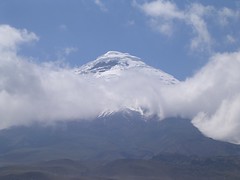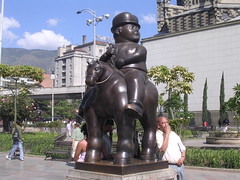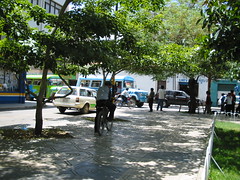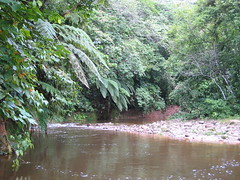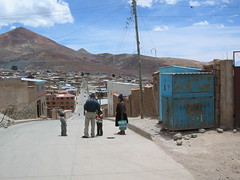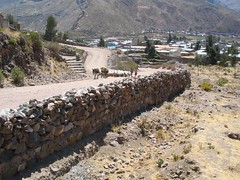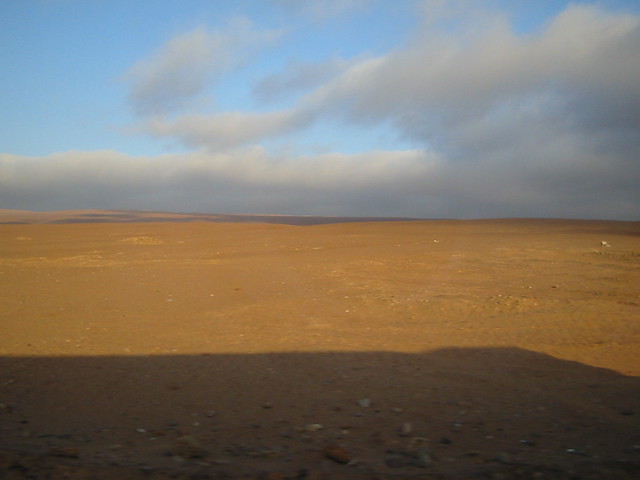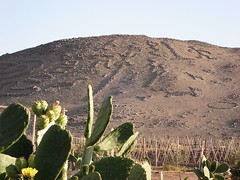Baños is a small city which rises in a flat piece of land, where the Andean valleys begin their tortuous descent towards the Amazon basin… we get there leaving the Pan-American highway near Ambato, city center of one of the most colored carnivals of Latin America (“fiestas de las flores y las frutas”). In the subtropical climate of Baños meet all the forces of nature: the Tungurahua volcano that dominate the village and it’s currently in eruption, frequent earthquakes, some impressive cascades and the clouds that incessantly thickens on the flanks of the mountains. In reason, the inhabitants of Baños talk with emphasis about the last eruption of the Tungurahua (August 2006), when part of the pueblo was destroyed. However, several Ecuadorian tourists come here, attracted by the hot springs of warm and sulfurous water; we also find a pleasant place, where we have a good time before the breathtaking descent towards the Amazon river basin.
Cotopaxi National Park
Exactly in front of the bridge which is the entrance gate to the city of Latacunga, a young boy tell us to go up on its rickety bus. It’s early in the morning, we begin the travel towards the covered by snow and perfectly conical top of the Cotopaxi volcano. The road rises inexorably: three, four, five thousand meters, the landscape becomes even more impressive. The silence owns these windy places, lived by the only animals have been able to adapt to the hard Andean climate (alpacas, condors, pumas, wild horses). For a moment we dream to go up till the top of the Cotopaxi crater to dominate an exterminated horizon, but climbing the highest active volcano of the world is not an adventure that could be organized in five minutes… some horses, pride of their freedom, follow us suspiciously while we walk around the Limpiopungo lagoon. Three big condors of the Andes caress the lost in clouds peak of the Rumiñahui volcano, where a warm and blinding sun (the god Inti in the Incaic culture, indeed) tries to open itself the way in the foggy cover.
On the way back we pass near Saquisili, a village which is center of one of the most colored Ecuadorian markets, every Thursday.
Medellin, Botero and Pablo Escobar
Medellin is the city of the Colombian social-economic supremacy, risen in the middle of nowhere and exploded under the protecting wing of the drug traffics. The utopian project of Pablo Escobar: a modern and efficient center, enclosed in a wonderful and green valley, where the Andes become bluffer. Medellin and the skyscrapers, the metropolitan, the suburbs and the favelas, where young people can’t see a future and have as unique hope sniffing glue. Medellin and the extension of our visa, a real bureaucratic odyssey. Medellin and the portrait that Fernando Botero paints, a colorful and eccentric society, animated from voluptuous, sensually opulent personages. The 50’s, the time of the flowers and the brothels (www.museodeantioquia.co).
Santa Cruz and oriental express
After spending a long period in the andean altitude, going down back to the amazon basin is an emotion, not matter if the climate becomes extremely hot and humid. Santa Cruz de la Sierra is located in the middle of the internal Bolivian trades, but also to and from other neighboring Latin American countries (Brazil, Paraguay, Argentina). No surprise that Santa Cruz, without being a city with intense history, is now the economic capital of Bolivia and the final goal of intense internal migration, driven by the search for work. Santa Cruz is already a frontier town in the east direction, because the Brazilian giant is closed and because it shares a strip of land with Paraguay called the Chaco: a sort of Latin American savannah, a sparsely populated and semi-arid area, turning into the Pantanal at the border, thanks to the influx of water from the Paraguay River and tributaries.
This territory is crossed by the oriental express train, a steel serpent that daily connects Santa Cruz to Quijarro, Bolivia’s last piece of land before Brazil.
Cochabamba and Villa Tunari
We listen for hours to the music that comes from the depths of the jungle: all this cosmos of lush greenery, mysterious animals and craftsmen of nature breathe in unison, incessantly. At the edge of this fabulous world lies Villa Tunari. Crossing point between the Andes and the Amazon Basin, between the brown and the green world. It does not surprise that in the pan-amazonian culture the green takes so many nuances, that is identified with different words in the indigenous languages. Over the Chapare river, where the chaotic progress launched its challenge to nature, there is still not a clear winner, but losing such a wealth of energy, culture and harmony would be an unforgivable crime.
And Cochabamba is watching us in disbelief, in its eternal spring above the misty amazon, proud of its fights that made it an example in the world for having firmly established the right to water as a common good.
Potosi the rich and buen vivir
A long way between La Paz and Potosi, the map deceives: they are more than ten hours by bus through the wildest Bolivian Andean plateau. “I am Potosi, the rich”… Thanks to the largest silver mine in the world, this city has experienced an incredible colonial splendor, in large part still visible because since the hunger for silver is decreased, the time stopped in Potosi. The city is now a fossil of a glittering past, a gem set among the peaks that, given the exaggerated altitude of the Andean plateau, are reduced to mere hills, bare and colorful. The people are friendly and gladly tell the secrets of Potosi: its quiet, its festivals, the hidden beauty, the characters who lived there and the countless numbers of miners who have left their lives chasing the ephemeral wealth in the bowels of the Cerro Rico, in the den of the devil.
It applies well to Potosi the concept of Bolivian buen vivir, a series of propositions and recipes married by the Bolivian people, at least in words, with the vision to ensure a future of consensus and sustainable progress, in harmony with the mother earth and respecting the cultural specificities of Bolivia, a vast and diverse country stretching from the Andes to the Amazon, with a kaleidoscopic wealth of cultures. One of the postulates of living well is to know how to eat well. In Potosi we taste a dish that well summarizes the concept, the k’alaphurka: a delicious soup of tomato, pepper, ají (hot sauce), choclo (young corn), some meat and spices, which is cooked in pumice stone and served in an earthenware dish. A plate of great topicality due to its simple origin and local ingredients.
Condor and Colca valley
At the station in Arequipa, few travelers mingle with the multitude of people who return to their villages of origin, after a visit to relatives in town or after a day’s work. They are natives who go in many small pueblos that dot the Andean valleys. We follow a similar route and head to the Colca Valley, we cross lands lashed by a cold wind, the Andean paramo and steps that reach 5000 meters. We are surrounded by pastures, flocks of llamas and alpacas and meager huts of Aymara farmers who live following their animals in the perpetual movements in search of forage. The nomadic life. We arrive in Chivay, a village at the mouth of the Colca Valley, where the atmosphere is extremely quiet and where there are still strong ties with ancient life styles. To prove it, a subtle distrust that local people show towards us. Time seems to be suspended in this valley, the life cycle chases the sun and the technology did not upset this delicate balance with the electricity. Chivay is situated about 3800 meters above sea level and that in itself would be enough to make life tough: the soroche, as it is defined in the local language altitude sickness, relentless strikes those who are not born to such a life. The children are curious along the paths that lead to their huts outside the village, bringing with them some animals, often sheep or alpacas. This is their daily task, instead of the school. They smile. On the slopes of the mountains surrounding the valley, looking carefully, you can see disparate groups of vicunas, the only species of Andean camelid that has not agreed to be domesticated and continues his lonely existence in the most inaccessible places in the Andean cordillera. Higher up, in the clear sky of the morning, sail unperturbed rare condors of the Andes, the real rulers of this majestic paradise. In Pinchollo, faded images of a distant past resurface in the timid glances of the people, and they tell us …
“I was chewing coca four years old
alpacas were faster than me
I was still chewing coca ten years old
the ground was harder than I
I was still chewing coca twenty years old
the children were crying louder than me
Now I am almost thirty years old
and I continue to chew coca
because my children have left
but I was too sad wherefore
death would take me too
and time to weep
Here on the plateau, there is none”
Arequipa and Juanita, Inca ice maiden
Arequipa, a jewel set in the wide valleys of southern Peru Andean plateau, is known from the Peruvians as the white city. A quiet and hospitable city, where to acclimatize before the rise in remote parts of the Andes. The drown tops of three volcanoes brush the city, the misti (gentleman, with its perfectly conical shape), the Chachani (beloved) and Picchu Picchu (high high) in the Quechua language. In the basement at the Convent of Santa Catalina, in an eternal embrace, lies the mummy of a girl (nicknamed Juanita, or Inca ice maiden) sacrificed in a ritual at Mount Ampato by the Incas 500 years ago. The encounter with a “viejo loco”, as he introduced himself, gives us a glimpse of Latin America, sitting in a tiny square of Arequipa, under the shade of some orange trees in bloom, we begin a long conversation on the life and traditions of the Andes and Arequipa. He traveled widely as a young man, being a street artist, and his memories are still bright. We discussed the magical combination of moods, colors, flavors, music and experiences that brings the traveler in his pilgrimage. In Arequipa it’s easy to meet lots of people, also because the climate is very hospitable. We receive an invitation to the home of a boy, out of town. We get to know their grandparents, who take care of alfalfa and corn fields and prepare for us a rich and delicious lunch accompanied by abundant traditional chicha, a fermented drink produced from corn. Sitting around the fire we eat and listen with interest the story of their lives, amid joys and sacrifices. After lunch, we learn the basics needed to play the Quena, the typical flute used in Andean music.
Andean highlands, desert and telescopes
Beyond the Valley of Azapa endless stretch the Andean highlands, where the desert becomes a spectacular red livery. It seems to land on Mars. On a fifty years old chevrolet car, we follow a faint-track in this inhospitable land in the direction of Putre, the town that serves as a starting point for visits to Lauca National Park and the ascent to the volcano Taapaca. In this portion of the plateau, the nature shows all its magnificence and hardness. Scattered groups of vicunas escape hopping as soon as they hear the noise of the car approaching. The wind whips the faces of the natives who, consumed by the sun and altitude, are covered in a last attempt at defense. The link between earth and sky has always been part of the cosmogony of the Andean peoples, inevitable is the attraction to these mountains and the altitude of the plateau caused to civilizations that lived in these places. Still this yearning for the infinite is well represented by the presence on the andean highlands of several research centers using large telescopes for the observation of space and celestial bodies. Examples are the Panaral Observatory, Cerro Pachon and Las Campanans observatory. In exceptional years, the rare rains return to wet lands of the arid Atacama desert, causing an explosion of nature to appear in the form of endless expanse of green lawns and bright flowers, of which many insects feast insatiable. They perfectly know that the desert gives little time to abundance.
Arica and Azapa valley
Arica is the northernmost seaport of Chile, a few kilometers from the border with Peru. Like all places at the border, the entire city is a huge market where goods are exchanged and where people argue passionately about the prices of agricultural products and textiles, surrounded by the pleasant smell of typical Andean food: empanadas, chicharrones and rocotos rellenos. A colorful and friendly crowd that accompanies the life of this bustling community. A few kilometers from Arica, inward and towards the Atacama desert, lies a green jewel, an oasis of palm, fruit and olive trees that unexpectedly grows on the sides of a small seasonal river, the San Jose. The special climate of this valley, that is called the Valley of Azapa, allows the cultivation of various fruits, vegetables and palm trees and the famous Azapa olives, typically purple colored, enabling the production of a special oil. Thanks to these special and favorable climatic conditions, the Azapa Valley has been inhabited by humans since ancient times. The Archaeological Museum of San Miguel Azapa tells the last 10000 years of history of this land, through the beautiful Tiwanaku dresses found in many cemeteries in the area and through the Chinchorro mummies, curled up in a final infinite reflection. The whole valley is surrounded by hills that were exploited by Andean civilizations as open books to tell their history through representations of rock art (petroglyphs) of extraordinary complexity and size. The Azapa valley is an incredible testimony of wealth and distinction that gives a clear idea of the cultural and religious and scientific knowledge of Andean peoples, from the past until nowadays.

